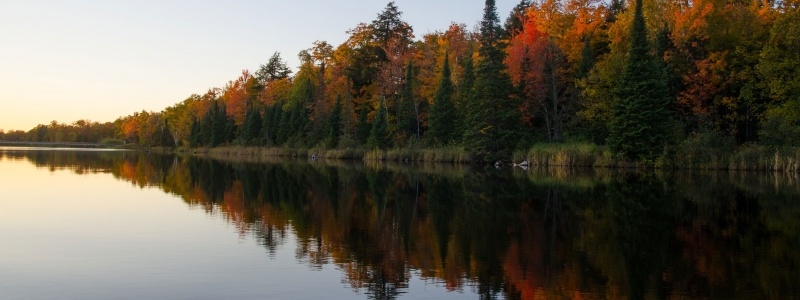Our ongoing work affects Michigan Tech lands, but also has impact felt around the world, from extreme-weather testing for composites to evaluating logging practices. Ford Center and Research Forest (FCRF) has more than 150 ongoing projects in addition to the list we share here, including remeasurements, and extensions of older studies. Contact us if you'd like to know more.
Research Projects, Studies, and Demonstrations (partial listing)
Best Management Practices Demonstration Area—50 sites across FCRF with water quality techniques implemented on forest roads (culvert replacements, upgrades, timber bridges, temp bridges, PVC pipe mats, rock-lined channels, open-top culvert, water bars, diversion ditches, check dams, etc. (Schmierer, Forsman).
Soil Warming, Tree Physiology Response Studies—Intensive study in Section 18, MU10 to heat upper soil horizons to approximate 2100 projected conditions to study soil and tree respiration, tree physiological responses, understory vegetation response, etc. (Burton and others).
Northern Hardwood – Silvicultural Experiment for Enhancing Diversity (NH-SEED)— Research experiment and demonstration area in Section 19, MU1 involves initiation of shelterwood (high and low residual), selection system (individual and small group), and clearcut methods to determine effects on regeneration, residual growth, understory response, soil microbial community, etc. and operations research in logging equipment efficiency ( Webster, Froese).
Canopy Tower and Canopy Cables in Temperate Northern Hardwood Forest—Free- standing 70-foot tower plus upper canopy cable system in Section 18, MU8 for study of canopy, tree, and leaf dynamics, tree and forest physiology, etc. in post-harvest northern hardwood reserve area that has been unmanaged since 1938 (Cavaleri, others).
LIDAR Acquisition for Ford Forest—Detailed LIDAR data collection for Ford Forest and lands directly adjacent in 2012 and to be repeated in 2017 for forest inventory, modelling, change detection and structure characterization (Edson, Hyslop).
Forest Inventory/Stand Imputation Model—Establishment and measurement of a random network of 1/10th acre plots across Ford Forest and Baraga Plains to allow modeling and verification of forest stand attributes via FVS, mathematical models, algorithms, and spatial statistics in GIS.
Decomposition, Carbon Dynamics and Fluxes in Aspen Stands—Establishment of small study plots within young aspen stands to study rates of decomposition across soil gradients as well as carbon dynamics and fluxes of decaying material in Sections 2, 12, and Prickett Dam Tract (Resch and Kane).
Wireless Communications Tower—Installation of wireless communications tower in Section 19, MU6, linked to high speed internet for data collection and monitoring and support of future wireless sensor network on FCRF to provide about 90-percent coverage with small shadow south of tower (Burton).
Facilities Upgrades and Conversion to Wood Boilers—Remodeling of Carriage House (old garage/storage building) into a modern wet/dry lab with proper equipment for measurement, processing, and storage of field samples (balances, drying ovens, freezers, bench space, etc.) as well as hands on teaching and outreach activities; installation of state of the art wood boiler systems in dorm and maintenance buildings (Burton).
Renewable Energy Adaptation Assessments and Projects for Alberta—Working with Keweenaw Research Center and Alternative Energy Enterprise teams to identify and implement energy conservation and efficiency upgrades as well as renewable energy projects on various buildings around Alberta Village (Meldrum, Green, and others).
High Energy Test Site—Five-acre area in Section 15, MU15 in a remote portion of forest cleared and improved for special testing of explosive forces on military vehicles and associated equipment and apparatus (Gruenberg, Bradley).
Monitoring Site for Detection of Heterobasidion—Natural red pine stand in Section 12, MU11 as part of monitoring network in NE Wisconsin and W Upper Michigan to determine extent of fungal distribution in red pine stands and investigate possible cases on the ground as pockets of decline are located (Bal, Richter).
Sugarbush Management and Maple Syrup Production—Now a 1 credit course offered by SFRES at Michigan Tech, also includes FERM and other students in tapping maples in and around Alberta, sap collection, storage, boiling and bottling, and sugarbush forest management, as well as outreach activities to the general public and K-12 schools. (Bal, Schmierer).
Exposure Studies—Small monitoring area at the edge of Alberta in Section 18 to test various materials, composites, coatings, etc. in extreme environments like Alberta (with extreme seasonal swings from -50F to 90+), and other sites across the country that represent extreme humidity, rainfall, temperature, etc. (Larkin and Eskola).
Genetic Diversity and Gene Flow in Oaks—Series of samples taken from isolated red oak and pine oak trees and stands at FCRF, Dow, and Tech Trails to determine specific genetic markers, identify distinct populations, determine degree of hybridization and gene flow, and relate to genotypes to phenotypes for better informed silvicultural decisions (Gailing and others).
Greenhouse Study—Researchers from UW–Madison set up several micro-greenhouses at the edge of Alberta Village to quantify the biophysical drivers of the subnivium in differing cover types and over a latitudinal range under different warming scenarios to serve as the basis for predictive modeling across the Great Lakes region, and the bioclimatic data collected in a series of physiological experiments will help to determine the effect of the changing climate on the physiological processes of freezing in wood frogs, an indicator species of the subnivium (Pauli and Zuckerberg).
Summary of Recent Research and Management Activity, partial listing of research projects, studies, demonstrations, Ford Center and Research Forest 2009-2017, compiled by School Forester, Jim Schmierer.
